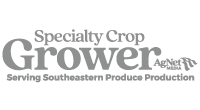By Sarah Strauss, Emma Dawson, Gabriel Pugina, Ute Albrecht, Jonas Pereira de Souza Junior and Davie Kadyampakeni
While soil health has always been considered critical for Florida citrus production, it has increased in importance with the endemic presence of citrus greening (HLB). Soil health is similar to the concepts of soil quality or soil fertility but with an additional focus on soil biology, such as earthworms and microbes. Soil organisms are key components of nutrient availability and can impact disease and pest control, so they are critical to soil health.
Improving soil health can increase soil water-holding capacity, nutrient availability and microbial activity. Since one of the key effects of HLB is fibrous root loss resulting in limited water and nutrient uptake, methods to improve soil health could help address these effects and assist grove recovery.
By definition, a healthy soil can sustain plants and other organisms without added inputs. For Florida agriculture, improving soil organic matter (SOM) is one of the best ways to improve soil health. Organic matter is naturally built by decomposition of plant material and microbes. This material provides energy (carbon) to soil microbes and can alter soil stability and water-holding capacity. Providing more resources for soil microbes can increase their diversity. This could include, for example, increasing the abundance of microbes involved in nitrogen (N) cycling.
Most Florida citrus soils have a very low SOM content (1% or less) compared, for example, to the soils of the Everglades Agricultural Area which can have a SOM content of more than 80%. The low SOM combined with the hot and wet Florida climate makes increasing SOM a slow process and long-term commitment. While planting cover crops and applying compost have resulted in increases in SOM in research trials and commercial groves, University of Florida Institute of Food and Agricultural Sciences (UF/IFAS) researchers have not yet measured any significant improvements in tree health and productivity. Use of these methods could take over five years before improvements to trees are seen.
COVER CROPS
Cover crops are crops planted with the primary goal of improving soil health. They are not harvested for profit. These plants release compounds into the soil that attract specific microbes potentially involved in nutrient cycling and root growth. For example, legume cover crops will form symbiotic (or win-win) relationships with N-fixing bacteria and can therefore increase soil N. When cover crops are terminated, the plant biomass provides carbon to soil microbes and can contribute to building SOM.

Photo by Kevin Hill
UF/IFAS research trials with annual cover crops in citrus groves (Figure 1) found increases in SOM and microbial diversity, including microbes with plant-growth benefits and N cycling capabilities. Although cover crops are mainly planted in the row middles in citrus groves, they can still impact citrus production as the roots grow beyond the canopy edge. See previous UF/IFAS articles in Citrus Industry magazine (Volume 101, No. 10; Volume 103, No. 6; Volume 104, No. 6) for more information on growing cover crops in citrus.
COMPOST
Compost application, like cover crops, is not a new method and can improve SOM. Many types of organic materials can be used to produce compost, though animal manure and yard waste are the most common. It is important to acquire compost from reputable vendors that can provide certified information about the properties of the compost. This includes nutrient concentrations, carbon to nitrogen ratio, pH, etc. Compost is generally applied to the tree rows at rates of 5 to 10 tons per acre per application.
In a UF/IFAS research trial, applying compost twice a year at a rate of 5 tons per acre significantly increased SOM after one year (Figure 2). However, in another trial, the impacts of compost application on soil nutrients and microbes associated with the tree roots (i.e., the rhizosphere) was influenced mainly by the rootstock cultivar.

For example, there were greater differences in the composition of microbes around the citrus roots of rootstocks US-812 and US-897 when compost was applied compared to US-802 and X-639. These greater changes in the microbes were also related to increases in magnesium, zinc and manganese in the roots.
OTHER AMENDMENTS AND COMBINATIONS
There are a wide variety of other commercially available soil amendments advertised to benefit soil health. Humic acids are extracted from organic products such as lignite and have large amounts of carbon, which could be helpful for increasing SOM. The standard application rates are highly variable ranging from 20 to 800 pounds per acre and can be applied in liquid or granular forms.
However, in a recent UF/IFAS trial in a commercial citrus grove where approximately 670 pounds per acre of humic acids were applied around trees twice a year, researchers observed no improvements in SOM and only a few changes to soil microbes after two years. It is possible that higher application rates of these amendments over a longer duration might be necessary to see increases in SOM.
Combining amendments and cover crops can also benefit soil health. In a study on the Central Florida Ridge, soil nutrient availability improved when cowpea or sunn hemp cover crops were planted, and citrus peel powder was broadcast over the planted seeds. Soils with cowpea and peel powder application had higher concentrations of macronutrients, including N, phosphorus (P) and calcium (Ca) as shown in Figure 3.

In contrast, soils with sunn hemp and peel powder had elevated levels of micronutrients, particularly zinc (Zn) and copper (Cu). Organic orange peel amendment significantly increased P and potassium (K) content with both cover crops. These findings underscore the importance of selecting appropriate cover crops and fertilization strategies to optimize nutrient cycling, enhance soil fertility and promote sustainable citrus production.
Acknowledgment: Projects are supported by the U.S. Department of Agriculture (USDA) National Institute of Food and Agriculture (NIFA) Emergency Citrus Disease Research and Extension Program #2020-70029-33202, USDA NIFA Agriculture and Food Research Initiative #2021-67019-34240 and USDA NIFA Multistate Hatch #006496.
Sarah Strauss (strauss@ufl.edu) and Ute Albrecht are associate professors; Emma Dawson and Gabriel Pugina are Ph.D. students — all at the UF/IFAS Southwest Florida Research and Education Center in Immokalee. Davie Kadyampakeni is an associate professor, and Jonas Pereira de Souza Junior is a postdoctoral research associate, both at the UF/IFAS Citrus Research and Education Center in Lake Alfred.
Share this Post
Sponsored Content










